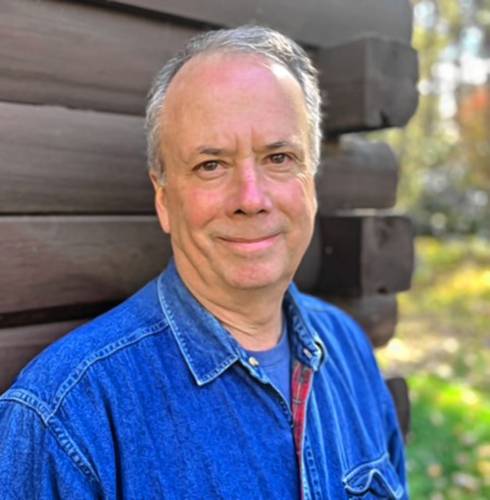Jarvis Coffin: Off the Highway – The white wood aster

Jarvis Coffin COURTESY PHOTO
| Published: 08-25-2023 11:50 AM |
The white wood aster is blooming, generally the last plant of the season around the property to issue its flowers, white daisy-like creations with a pale yellow center.
For years, I mowed them down or weed-whacked them. They grew around the edges of the woods, not looking like much: spindly stems, jagged-edge leaves, pronounced veins that made them appear wilted. Not especially elegant. But I fell behind with the landscaping, which allowed them to propagate, and at the end of the first summer after we moved to the pond for good, we had a white border running around the yard, arriving just as we were beginning to lament the end of the growing season.
It was perfectly timed to lift our spirits. Now we cultivate the darlings.
There is a metaphor for life in that, which I invite you to dig out if you wish. I work at metaphors these days. All of them arise from the natural world. I am reading a book by Rebecca Makkai, a marvelous author, National Book Award and Pulitzer Prize finalist. The book is “I Have Some Questions for You,” which you may have read. In one scene, she describes the light coming through the windows of her old school.
“It was different there,” she writes, “older, passing through centuries before it reached you. Outside in winter, it came down in needles; inside, it fell like soup.”
I have no idea what that means. But I have experience living as a young student in the sort of old building she describes, with light passing through dusty, lead-framed windows, sunk into thick stone walls, like castle walls, and she nails it. Great metaphors make you feel something.
Anyway, I am very protective of our wood asters now, though they are not, in fact, asters. They are cousins. They are eurybias. We do have proper asters. We have both the whorled wood aster and the blue wood aster. The whorled wood is plentiful around us. The other is not.
I have lost track of it, actually. It is around here somewhere, but I forget where. I have an app, you see, that helps identify plants, and over the past few years I have snapped countless pictures of the perennial population around us so that the catalog is now overwhelming, and locations not well documented. Not documented at all, I am afraid.
Article continues after...
Yesterday's Most Read Articles
 Peterborough voters approve a $11.7 million bond to fund a new Fire and Rescue Station
Peterborough voters approve a $11.7 million bond to fund a new Fire and Rescue Station
 ConVal’s Kimberly Rizzo Saunders named Superintendent of the Year
ConVal’s Kimberly Rizzo Saunders named Superintendent of the Year
 Reality Check receives approval to move into Redeeming Grace Church
Reality Check receives approval to move into Redeeming Grace Church
 Frank Edelblut speaks at Dublin Education Advisory Committee forum
Frank Edelblut speaks at Dublin Education Advisory Committee forum
 New look at Gregg Lake
New look at Gregg Lake
The plan is to retrace my steps around the property – about four acres – to make careful notes of the more-desirable varieties. I am thinking particularly of the common buttonbush, trailing lantana, Carolina rose, sweet woodruff (which I would like to move to a couple of places that need ground cover), pink lady’s slipper (these are cropping up around footpaths; the dog wiped out a couple of them this summer) and red raspberry.
The raspberry is particularly frustrating. Who would not want to cultivate raspberries? We have velvet leaf huckleberry and California blackberry plants (also Allegheny blackberry according to the app). I know where those are and have pruned along the way. But I have not found the raspberry, albeit after a superficial search a few weeks ago. But I have the picture, evidence that it is here.
We also have the little wild strawberries that grow like a net through the grasses of one particular hill. There was not a good crop of them this year, perhaps because of the rain. Last year, our 6-year-old granddaughter filled a pint container with them.
I doubt there is anyone who does not have something to say about what all the rain we had this season did to certain plants and crops. The lettuce in our gardens has overachieved. It has been bountiful. Big red and green leaves billowing over the frames of the raised beds. The carrots have also done well, and the potatoes. I am going to start plucking beets soon. The tomatoes, on the other hand, are weeks behind. There are blossoms and a few walnut-sized fruit dangling from the stems. If we get tomatoes at all, it will be the end of September. I have heard this from many people.
Last year, we did not have any water. This year we had too much. Nature has a wonderful way of evening the score. You win some, you lose some, some get rained out. But you dress for them all, as a friend says.
There is a metaphor in that, which the white wood aster knows.
Jarvis Coffin and his wife Marcia owned New Hampshire’s oldest inn, The Hancock Inn, during which time he wrote a popular newsletter for the inn’s mailing list. Retired from innkeeping, he now writes full-time, mostly essays on rural life and fiction. You can reach him at huntspond@icloud.com, and visit postcard-from-monadnock.ghost.io to keep up with his other musings on the Monadnock Region.


